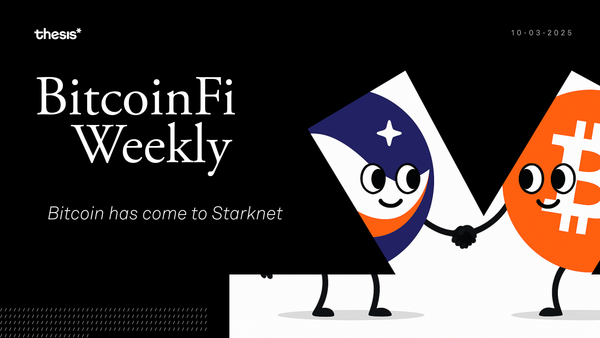Recapping OP_NEXT 2025
OP_NEXT showcased the future of Bitcoin, debates, practical scaling, and tools for real self-custody. From CTV to vaults and L2 economics, a new consensus is forming. No hype, just builders. Catch our full breakdown in this week’s BitcoinFi Weekly.

Welcome to BitcoinFi Weekly. We cover where people use their BTC and what is changing in the Bitcoin world.
Nobody yelled. Nobody promised the moon. There were no product launches, no laser-eyed messiahs on stage. OP_NEXT felt like true, genuine progress. Not the kind that gets you retweets, but the kind that gets you better tools. The kind that will help secure your future. Somewhere between the espresso machines and the half-finished slides, a sense of bubbling optimism took shape. A feeling that the right people were in the room, saying the hard things out loud. Bitcoin is far from perfect, but the path forward is clear. Fewer slogans. More safeguards. In today’s edition, we share our takeaways from what’s quietly becoming the world's most important Bitcoin scaling conference. Let’s dive in.
Here’s this week’s rundown:
🤓 Feature Piece: Recapping OP_Next
🌋 Babylon BTC Staking Goes Live
🏛️ Introducing Tanari
⚡ Starkware Announces ColliderVM
Feature Piece: Recapping OP_Next
Nestled in the rolling green hills of Tysons, Virginia, Strategy’s glass headquarters gleamed against the spring sun. There were hoodies. There were suits. There was espresso. And there were ideas.
The crowd wasn’t spilling over, resembling more of a quorum. A quorum of Bitcoin's strongest believers. This wasn’t a conference so much as a fault line. To put it plainly, OP_NEXT was a gathering of people trying to push Bitcoin forward...or at least stop it from drifting backward. However, one thing was immediately apparent: If you wanted to understand where Bitcoin might go next (technically, philosophically, institutionally), OP_NEXT was where the signals originated.
Takeaway 1: Ossification Is Not a Binary
Bitcoin's success has created its central paradox: the more valuable it becomes, the stronger the case for stability, yet the more urgent the need for growth. This tension dominated OP_NEXT.
Success demands stability. The trillion-dollar network carries too much wealth to risk breaking. Yet avoiding change brings its own dangers. Without improving self-custody, scaling capacity, and security models, Bitcoin might ossify into irrelevance. Bitcoin in 2025 is not the Bitcoin of 2017. Institutional adoption has fundamentally changed the ecosystem and the stakes of governance decisions.
Major custodians like Coinbase, BitWise, and Anchorage unanimously opposed complete ossification, citing fiduciary duties to clients. While individual Bitcoiners might embrace stasis, institutions need a roadmap for improvement. This creates a new dynamic: retail users push for sovereignty while institutions demand reliability.
At the end of the day, perfect money is worthless if unusable.
The deepest risk identified was not one of technical failure but of a philosophical nature: Bitcoin might secure its code while abandoning its mission. Sean Ryan from Anchorage noted that the lack of secure self-custody options like vaults pushes users toward custodial solutions, undermining Bitcoin's core promise. Jeremy Rubin argued that without CTV, even basic security upgrades become impossible, leaving users vulnerable.
What makes this contradiction so difficult is that both sides are fundamentally right. The ossification camp correctly identifies protocol stability as Bitcoin's most valuable feature. The evolution camp correctly notes that usability and security gaps threaten adoption.
Bitcoin breaks if we change nothing. Bitcoin also breaks if we change the wrong thing, became the conference's unofficial thesis.
Takeaway 2: Widening Consensus on Upgrades
Three immediate priorities for Bitcoin’s future rose above the rest:
- safer self-custody
- practical scalability
- sustainable security economics
The most striking evidence of this consensus was the surprising support for CTV (CheckTemplateVerify). This upgrade proposal, shepherded by Jeremy Rubin, has unified previously divergent communities. BitVM developers, flipped pro-CTV once they saw it helps better enable BitVM. The Taproot Wizards community joined in support. Even certain mining pools (traditionally the most conservative stakeholders) have shown favorable support. CTV offers concrete benefits without ideological baggage. It enables vaults that let users "pre-signal" a spend and cancel it if hacked, making self-custody safer for both individuals and institutions. It powers congestion control and payment pools without introducing Ethereum-style complexity. Critics of CTV can't propose alternatives that aren't either broken or require CTV anyway.
Steven Roose's analysis of how CTV would benefit Ark, exemplified this practicality. While Ark can work without CTV, the upgrade would enable direct user-to-user payments within a round, channel-less Lightning Network receive capability, and efficient mass payouts, vital for mining pools and exchanges. CTV creates an elegant, deterministic execution path that simplifies the entire protocol.
The support for CTV isn’t unanimous, but it is diverse. And that, in Bitcoin, means more.
A similar pragmatic shift was visible in discussions around scaling. Gone were the ghosts of 2017’s block-size wars. In their place were measured conversations about thermodynamic security, or the idea that Bitcoin must find a way to sustain miner incentives as the block subsidy shrinks. Jameson Lopp’s proposal for a dynamic block size system was less about size and more about sensitivity. He argued for blocks that respond to fee pressure. Not to satisfy ideological purity but rather to ensure economic longevity.
What Lopp argued for was not big or small blocks, but blocks that matter. Full blocks. Efficient blocks. Blocks that can carry enough fee pressure to justify the cost of securing the network decades from now.
Whether you favor Ark, Spark, or some BitVM-inspired bridge, the shared concern was clear: self-custody must scale, and scale with guarantees. Off-chain systems that require constant coordination, trust in unaccountable intermediaries, or endless reboots every time your OS needs an update are not good enough. What matters now is designing for failure. However, these aren’t controversial positions anymore. They are baseline goals.
That’s what made OP_NEXT feel different. There was less arguing about what Bitcoin needs and more discussion on how to implement changes.
Takeaway 3: Economic Realism Is Finally Part of the Conversation
Perhaps the most sobering revelation from OP_NEXT was the true cost of scaling Bitcoin. Layer 2 solutions aren't free. In fact, they impose economic thresholds that could compromise sovereignty in ways few have fully considered.
Greg Sanders, made this plain in his talk. He walked through the economics of Lightning channel closures, timeout trees, and exit mechanisms in proposed rollup-like constructions. The math is brutal. When the fee market is active and blocks are full, closing a basic Lightning channel can cost tens of thousands of sats. More complex cases (i.e.: disputed HTLCs or nested contracts) can cost orders of magnitude more.
There’s a threshold, beyond which a user may hold BTC, but cannot retrieve it without losing a non-trivial portion of it to fees. When that happens, the line between non-custodial and custodial blurs. If you need to pay to exit, but the cost exceeds your balance, then your rights are theoretical. You are free in principle, but not in practice.BitVM bridges, too, point to this reality. In order to make the cryptoeconomic design work, the current instantiations require minimum withdrawal denominations of around 10 BTC. The system needs to amortize risk, bandwidth, and complexity. But this leaves a yawning gap between institutional security and individual accessibility. A bridge you can't cross with less than half a million dollars is just a gate.
This isn’t to say these systems are broken. They are brilliant in design. They push Bitcoin’s limitations farther than most thought possible. But brilliance does not absolve tradeoffs. And the hardest tradeoff of all may be this: Bitcoin can scale, but not everyone may come with it.
Unless protocol developers and wallet designers explicitly account for these economic thresholds ( reducing complexity, subsidizing exits, or building automatic migration paths), then the network will stratify. There will be those who can afford to exit, and those who must simply hope their coordinator stays online. Those who own their bitcoin, and those who lease it from an interface.
In that light, the value of proposals like CTV or CSFS becomes even clearer. Vaults can automate emergency exits. Payment trees can batch users together safely. Protocols like Ark become dramatically easier to implement. With the right primitives, we can build systems that keep the economic floor low enough for everyone to stand on.
But the principle remains: scalability is not free. Not in fees, not in complexity, and not in sovereignty.
We thank Blockspace Media, Strategy, Luxor, Taproot Wizards, and all the sponsors for creating such a vital forum where Bitcoin's future can be debated honestly and openly. In a space too often defined by hype and tribalism, OP_NEXT offered something rarer: nuance, expertise, and the courage to confront Bitcoin's hardest problems.
BitcoinFi Updates
Babylon BTC Staking Goes Live
Bitcoin staking on Babylon is now live, introducing what the company calls Bitcoin's "third native use case" after spending and holding. On April 11, 2025, Babylon Labs activated its Bitcoin staking protocol, allowing BTC to be staked to provide Proof-of-Stake security to the Babylon Genesis blockchain. This marks the first time in Bitcoin’s history that BTC can secure another chain while remaining in the staker’s custody.
Babylon's roadmap includes an airdrop of 600 million BABY tokens (6% of total supply) distributed across multiple categories, with the largest portions allocated to base staking rewards (335M) and a bonus for users who transition to Phase 2 staking (200M). The protocol eventually aims to extend beyond Babylon Genesis, enabling other decentralized networks to utilize Bitcoin for security in what they dub “Bitcoin Secured Networks.” Despite the technical milestone, early staking yields may disappoint some investors.
Introducing Tanari
A new Bitcoin financial application called Tanari has announced its development, positioning itself as "the first self-owned Bitcoin financial platform." The application promises to consolidate multiple Bitcoin financial functions (i.e.: payments, lending, stablecoins) into a single user interface while maintaining self-custody principles. Built on Citrea, Tanari employs passkey authentication and hardware-level security to eliminate traditional seed phrases, using biometric verification instead.
Tanari addresses what its developers describe as fragmentation in Bitcoin's financial ecosystem, where users typically manage multiple applications for different services. It uses RIP-7212, EIP-7702 and modular smart accounts based on EIP-7579. Tanari's roadmap includes a testnet launch, followed by a mainnet release and integration with additional Bitcoin applications developed on Citrea.
Starkware Announces ColliderVM
Starkware has announced research on ColliderVM, a new protocol designed to enable stateful computation on Bitcoin without relying on fraud proofs. This aims to facilitate trust-minimized bridges between Bitcoin and layer-2 networks like Starknet, combining elements from BitVM2 and the company's previous ColliderScript work. By facilitating stateful computation, ColliderVM allows for the execution of smart contracts that can persist across multiple transactions and user interactions, enhancing Bitcoin's programmability.
ColliderVM employs hash collision-based puzzles, replacing the one-time signature schemes used in prior models like BitVM. This approach significantly reduces computational overhead, making the verification of STARK proofs on Bitcoin more practical. The protocol's design ensures both safety and liveness, assuming at least one honest participant among signers and operators. Additionally, by eliminating the need for fraud proofs, ColliderVM improves capital efficiency (10,000 times more efficient), as operators are no longer required to lock substantial collateral. The system supports both STARK and SNARK-based bridge constructions, potentially making STARK proof verification on Bitcoin "nearly practical.”
Closing Thoughts
Bitcoin is still a fight. Not a fistfight, not a shootout. Something quieter. A war of ideas. A war of thresholds. A war against decay masquerading as safety. OP_NEXT didn’t offer salvation. It didn’t claim to. What it gave us was something stranger and maybe more honest: a glimpse of the work ahead, and the people willing to do it. What they’re building isn’t utopia. It’s scaffolding. For vaults that don’t lie. For scaling models that don’t make you beg to withdraw what’s yours. For rules that don’t depend on who you know or what country you're in. Bitcoin will not be saved by slogans. It will be saved (one can hope) by the slow, tedious, unglamorous work of people who care more about integrity than applause.
So here we are. Progress, measured not in price, but in the stubborn pulse of those who still believe. Still flawed. Still unfinished. Still in motion.
And thank god for that.
If there's a topic you’d like us to cover or have questions, reach out at [email protected].





